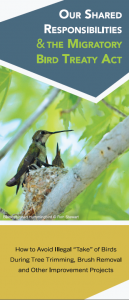Our Shared Responsibilities and the Migratory Bird Treaty Act: How to Avoid “Take” of Birds during Tree Trimming, Brush Removal and other Improvement Projects
 Each year migratory birds that are protected under the Migratory Bird Treaty Act (50 CFR § 10.12) are needlessly killed or harmed during the course of planned construction, tree trimming, mowing vegetation, and other habitat-altering projects.
Each year migratory birds that are protected under the Migratory Bird Treaty Act (50 CFR § 10.12) are needlessly killed or harmed during the course of planned construction, tree trimming, mowing vegetation, and other habitat-altering projects.
Nearly all birds in the United States are protected by the Migratory Bird Treaty Act of 1918, with except some upland game birds and non-native species such as European Starling and House Sparrow. Under the Migratory Bird Treaty Act, it is unlawful for anyone to “take” a migratory bird or their parts, nests, or eggs unless permitted to do so. The term “take” is defined as to “pursue, hunt, shoot, wound, kill, trap, capture, or collect.”
Many of the actions that impact birds are unintentional and many members of the public and private community do not understand their responsibilities under the Migratory Bird Treaty Act. With the goal of spreading information on the protection of birds, Great Salt Lake Audubon teamed with the U.S. Fish and Wildlife Service, Utah Division of Wildlife, and the Tracy Aviary to distribute information on the Migratory Bird Treaty Act. We received valuable input from Salt Lake City and Salt Lake County. Together, we have created and are distributing an informational brochure and “best practices” document to regional public managers and other interested parties.
Compliance with the MBTA and avoiding impacts to breeding birds can generally be accomplished by conducting habitat-altering projects when birds are not breeding. In Utah, the peak breeding season when most birds breed, is April through July.The entire breeding season for all birds, including raptors and eagles, is January through August. If projects can be timed to avoid the breeding season, impacts are greatly minimized or avoided.
Do you engage in activities at home or work that may impact breeding birds such as tree trimming or vegetation clearing? Plan ahead to implement your projects when birds are not breeding. It is not only the responsibility of public and private entities to protect migratory birds, it is the law!
For your own copy of the brochure and to learn more about best practices, go to www.greatsaltlakeaudubon.org

